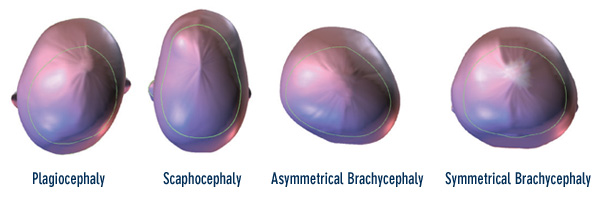Plagiocephaly often results from external forces applied to the soft infant skull. There are actually three main different types of misshapen heads. Causes of Plagiocephaly can also combine and overlap so it’s not uncommon to see a headshape that exhibits two of the deformities. These combinations may be referred to as “Asymmetrical Brachycephaly” or “Brachycephaly with Plagiocephaly” for example.

Are there other causes of head shape deformities?
Yes, another leading cause of abnormal head shapes in young babies is neck tightness caused by congenital muscular torticollis or neck/trunk muscle imbalance. Torticollis is usually caused by an imbalance in the sternocleidomastoid and other neck muscles, which prevents full range of motion in the neck. It is estimated that about 85% of the babies with deformational Plagiocephaly also have some kind of neck involvement. Typically, the head of a baby with torticollis is tipped to one side and rotated to the opposite shoulder, causing the head to consistently rest in the same position. The constant positioning of the head to the same side causes the head to become flat in the back. Torticollis can also pull abnormally on the base of the skull and cause the ear on the same side of the posterior flattening to be pushed forward. In severe cases, the forehead can also be pushed forward on the same side, and the facial features including the eyes, cheeks, and jaw may not be symmetrical.
Another condition to be aware of is Craniosynostosis. Craniosynostosis is a term that refers to the early closing of one or more of the sutures of an infant’s head. The skull is normally composed of bones which are separated by sutures. Learn More About Craniosynostosis Here.
Another postnatal cause of abnormal head shapes occurs when the back of the baby’s head rests for prolonged periods of time against a hard surface like an infant carrier, car seat, swing or stroller. Before 1992, babies were put to sleep on their tummies, which varied the amount of force on the back of the head. Since the American Academy of Pediatrics initiated the “Back to Sleep” program in an effort to end Sudden Infant Death Syndrome (SIDS), babies now spend all night on their backs until they are able to roll and reposition themselves. Unfortunately, the combination of the carriers we use to hold and position our babies during the day, and placing them to sleep on their backs all night has led to an increase in head shape deformities. It is very encouraging to note that the “Back to Sleep” program has reduced the incidence of SIDS by 40%, so it is important to follow the regime of putting your baby to sleep on his or her back. The best way to reduce the potential for head shape problems is to increase the time your baby spends on his or her tummy during the day while the baby is awake and supervised.
